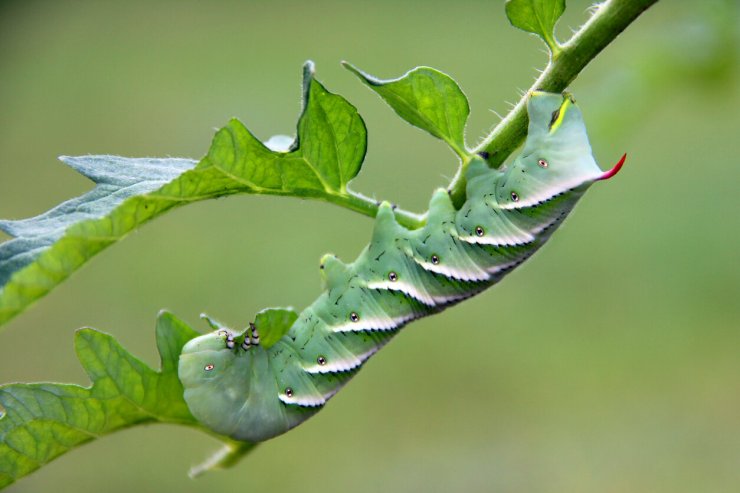I’ll never forget that morning, my daughter came running in from outside, yelling that I needed to come look at the tomatoes, which I’d neglected for the past week. What I found was a scene that looked like something had thrown a very exclusive, very destructive dinner party. My beautiful ‘Cherokee Purple’ tomato–the one I’d been babying since March–stood there looking positively skeletal. Entire branches were stripped bare, nothing left but sad little stubs where lush foliage had been just yesterday.
At first, I blamed the rabbits. Then the deer. But as I crouched down to investigate, something made me look up. There, clinging to what remained of a branch about eye-level, was the culprit: a tomato hornworm so perfectly camouflaged I’d walked right past it three times.

A tobacco hornworm in the tomato garden
Identifying the Hornworm
This wasn’t just any garden pest–this was Manduca quinquemaculata, the five-spotted hawkmoth caterpillar, and quite possibly the most impressive eating machine I’d ever encountered in my years of gardening. Here’s what to look for:
- Size: Up to 4 inches long and thick as your thumb
- Color: Bright green with diagonal white stripes
- Horn: Red or black horn on the rear end (completely harmless)
- Camouflage: Nearly invisible against tomato foliage
- Position: Often feeds along stems to enhance disguise
Amazing Camouflage Abilities
What struck me most was how perfectly invisible this enormous creature had been. Hornworms are masters of disguise, and here’s how they do it:
- Perfect color matching: Green coloration matches tomato foliage precisely
- Shadow mimicry: White stripes mimic shadows cast by leaf veins
- Strategic positioning: They align themselves along stems to enhance the illusion
- Stillness: Remain motionless during daylight hours
I’ve had fellow gardeners stare directly at hornworms for minutes without seeing them, even when I’m pointing right at them.
From Garden Pest to Pollinator
Here’s where things get really fascinating: these voracious caterpillars are destined for something magnificent. After spending weeks demolishing our tomato plants, they undergo a complete transformation:
- Pupation: Burrow 3–4 inches underground to pupate
- Emergence: Transform into sphinx moths (also called hummingbird moths)
- Adult form: Gorgeous creatures with 5-inch wingspans
- Pollination role: Hover at flowers like tiny hummingbirds, pollinating native plants at night
It’s like discovering that your garden vandal is actually Clark Kent. Not that it makes me any happier about my poor tomatoes.
Incredible Appetite and Growth
The hornworm’s appetite is legendary, and for good reason:
- Weight gain: Increase body weight by 3,000 times in just a few weeks
- Human comparison: Like a 7-pound baby growing to weigh 21,000 pounds
- Eating schedule: Feed almost constantly, only stopping to molt
- Plant damage: A single hornworm can consume an entire plant’s worth of foliage

Nature’s Own Pest Control: Parasitic Wasps
Nature has its own pest control system, though, and it’s beautifully brutal. Enter the braconid wasp, a tiny parasitic insect that uses hornworms as living nurseries:
- Egg injection: Female wasps inject eggs directly into the caterpillar
- Internal development: Larvae develop inside the living host
- Emergence: Eventually emerge to pupate in small white cocoons
- Identification: Look like grains of rice stuck to the hornworm’s back
- Management: If you find infected hornworms, leave them alone–the wasps will finish the job
Organic Control Methods
Hand-Picking (The Gold Standard)
For organic control, hand-picking remains the most effective method:
- Best timing: Early morning when caterpillars are most active
- Safety: Hornworms won’t bite, sting, or protest when removed
- Detection tip: Look for black droppings (frass) on leaves below damaged areas
- Frequency: Daily checks during peak season (mid to late summer)
The Chicken Solution
If you keep chickens, you’ve struck gold:
- Protein source: Hornworms are like caviar to poultry
- Happy hens: My chickens actually do a little dance when I toss them a hornworm
- Neighbor network: Even without chickens, find neighbors with backyard flocks
- Win-win: Pest control and chicken treats in one package
Companion Planting Strategies
- Basil: Plant near tomatoes to confuse hornworms and the adult moths who lay eggs
- Marigolds: May help repel moths (though science is mixed)
- Dill and fennel: Attract beneficial wasps nearby
- Extra tomatoes: Plant a few extra to account for “hornworm tax”
Their Ecological Role
After years of battling these green giants, I’ve developed a grudging respect for them. Here’s why they matter to the bigger picture:
- Adult pollination: Sphinx moths pollinate native wildflowers and night-blooming plants
- Food web support: Hornworms feed birds, spiders, and parasitic wasps
- Beneficial insect habitat: Support populations of helpful predatory insects
- Native ecosystem balance: Part of complex ecological relationships
Villain or Misunderstood Creature?
So are hornworms garden villains or misunderstood creatures? Like most things in nature, they’re both:
The Case Against:
- Can devastate a tomato crop overnight
- Nearly invisible, making detection challenging
- Voracious appetite destroys weeks of garden work
The Case For:
- Magnificently adapted creatures doing what nature designed them to do
- Transform into beneficial pollinators
- Support important ecological relationships
- Share our excellent taste in tomatoes (can you blame them?)
In my garden, I’ve learned to plant extra tomatoes specifically to account for hornworm tax, and I maintain a policy of live-and-let-live for the first few I find each season. After that, it’s chicken dinner time. I do find that basil is the best solution for keeping them away. I went YEARS without hornworms and the first year I didn’t weave basil between my plants, in they came.
The great hornworm heist taught me that even our garden nemeses deserve our fascination, if not our forgiveness. These remarkable eating machines happen to share our taste in tomatoes, and while that might make them garden adversaries, it also makes them worthy of our respect–and careful management.
Want to learn how to grow your own tomatoes?
Tomatoes are the most popular plant for home gardeners! With The Everything Tomato Gardening Guide, you’ll have everything you need to know about growing and enjoying this versatile food, from the history and background of the mighty tomato to specific advice on growing, harvesting, and enjoying your hard work!
What do you do with your tomato hornworms?


 Previous
Previous

